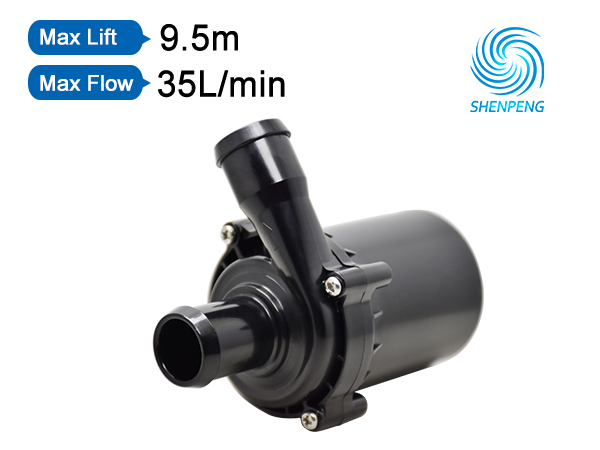Noise Control Technology for Smart Toilet Water Pumps: Enhancing Quiet Operation in Modern Bathrooms
Published:2025-09-09

In modern home bathrooms, the quiet operation of smart toilets has become a critical metric for evaluating user experience. As a core power component, the noise performance of DC brushless water pumps directly impacts the overall comfort of the toilet. Shenpeng Technology takes you through the technical pathways for pump noise control, providing systematic solutions for smart toilet manufacturers.
I. Dual Mechanisms of Noise Generation and Industry Pain Points
(1) Two Primary Types of Noise from Smart Toilet Water Pumps
Electromagnetic Noise (100-500Hz): Caused by magnetic field interactions between the stator and rotor inside the motor, it manifests as low-frequency "hum" vibrations. When the motor speed control signal frequency coincides with the pump’s natural vibration frequency, resonance easily occurs, amplifying the noise.
Mechanical Noise (500-5000Hz): Includes "rustling" sounds from bearing friction, "cracking" sounds from water flow impacting the impeller, and noise transmitted through the pump housing via vibrations. This type of noise increases significantly as the pump speed rises.
(2) Limitations of Traditional Solutions
Traditional noise reduction methods often rely on passive measures such as adding sound insulation foam or increasing housing thickness. These approaches not only add weight to the toilet and complicate installation but also fail to address the root cause of noise—since long-term exposure to the humid bathroom environment can degrade the sound insulation materials over time.
II. Three Core Technological Breakthroughs
(1) Suppressing Electromagnetic Noise in the Motor System
Asymmetric Magnetic Pole Design
By optimizing the arrangement of permanent magnets inside the motor, the magnetic field distribution is made more uniform. This effectively reduces torque fluctuations during motor operation, minimizing electromagnetic vibrations at the source—similar to equipping the motor with a "stabilizer" to ensure smoother, quieter performance.
Suspended Rotor Structure
Using air gap isolation technology to separate the rotor from the stator, combined with high-precision position control algorithms, the rotor’s offset during rotation is controlled to within one-tenth the diameter of a human hair. This drastically reduces the transmission of vibrations caused by electromagnetic forces.
(2) Low-Vibration Design for the Mechanical System
Fully Enclosed Self-Lubricating Bearings
Bearings are crafted from high-performance self-lubricating graphite material, which inherently possesses lubricating properties. Its friction coefficient is only one-third that of traditional metal bearings. When paired with precisely machined bearing mounting holes, the bearing operation noise is significantly reduced—testing shows noise levels are roughly half those of traditional solutions, achieving a whisper-quiet effect.
Bionic Serrated Impeller Blade Design
Inspired by the shape of pectoral fins in marine organisms, tiny serrated protrusions are added to the leading edges of the impeller blades. This design acts like "flow guide channels" for water, reducing noise caused by water impact on the blades while increasing pump efficiency by approximately 8%—achieving both noise reduction and performance enhancement.
(3) Vibration Isolation Solutions for the Structural System
Flexible Pipeline Connections
Elastic corrugated hoses replace traditional rigid pipes at the pump’s water inlet and outlet. This flexible connection acts like a "shock absorber" for the pump, effectively blocking the path of vibration transmission through pipelines and reducing noise conduction to the main toilet body. Testing confirms this reduces structural sound transmission by over 30%.
III. Full-Working-Condition Intelligent Noise Reduction Strategies and Experience Enhancement
To address different usage modes of smart toilets, built-in intelligent control algorithms enable precise noise reduction:
Hip Washing Mode (Low Flow): High-frequency drive technology is used to shift the noise frequency to a range less perceptible to human ears, making water flow sounds softer and avoiding disruptions during the user’s bathroom experience.
Flushing Mode (High Load): "Soft start" technology gradually increases the pump speed, preventing impact noise from sudden acceleration—ensuring stable, quiet operation even during high-power flushing.
Standby Mode: The pump enters a low-power sleep state, eliminating subtle vibrations caused by static electromagnetic forces and ensuring the toilet remains quiet when not in use.
As technology advances, future water pump noise reduction will integrate vibration sensors with active noise cancellation algorithms to real-time monitor and counteract noise, delivering an even quieter bathroom experience. For smart toilet manufacturers, choosing water pumps with professional noise reduction technology from Shenpeng Technology not only meets strict industry standards but also significantly enhances the premium quality of products—helping them stand out in a competitive market.
- Distribution in Water Heater Mattresses: Why BLDC Pumps Ensure Uniform Heating
- How BLDC Pumps Ensure Precise Flow in Water Dispensers
- Why BLDC Pumps Are Essential for Smart Toilets
- The Critical Role of Automotive Electronic Water Pumps in New Energy Vehicle Battery Thermal Management
- Noise Control Technology for Smart Toilet Water Pumps: Enhancing Quiet Operation in Modern Bathrooms
- Unveiling the Working Principle of Automotive Electronic Water Valves
- Comparative Analysis of Liquid-Cooled Pumps vs. Air-Cooled Systems for EV Charging Stations
- Technical Application of Brushless DC Motors in Energy Storage Circulation Pumps
- Water Heater Pump: Efficiency Upgrade for Low-Voltage Systems
- How Dishwasher Water Pumps Enhance Cleaning Coverage Through Stable Operation?
